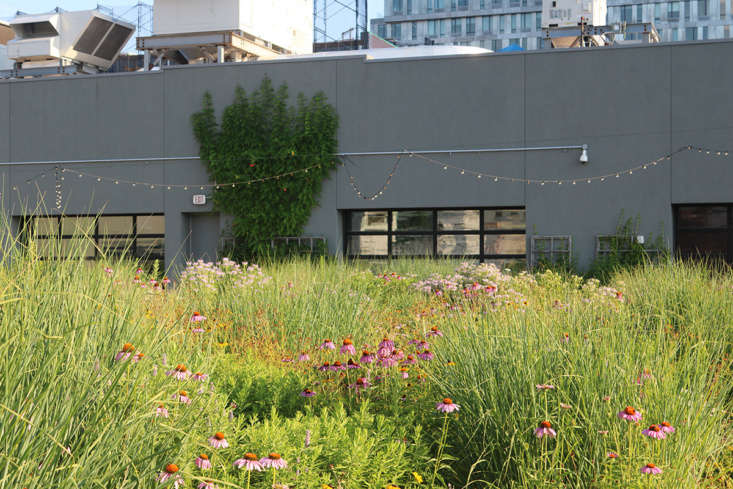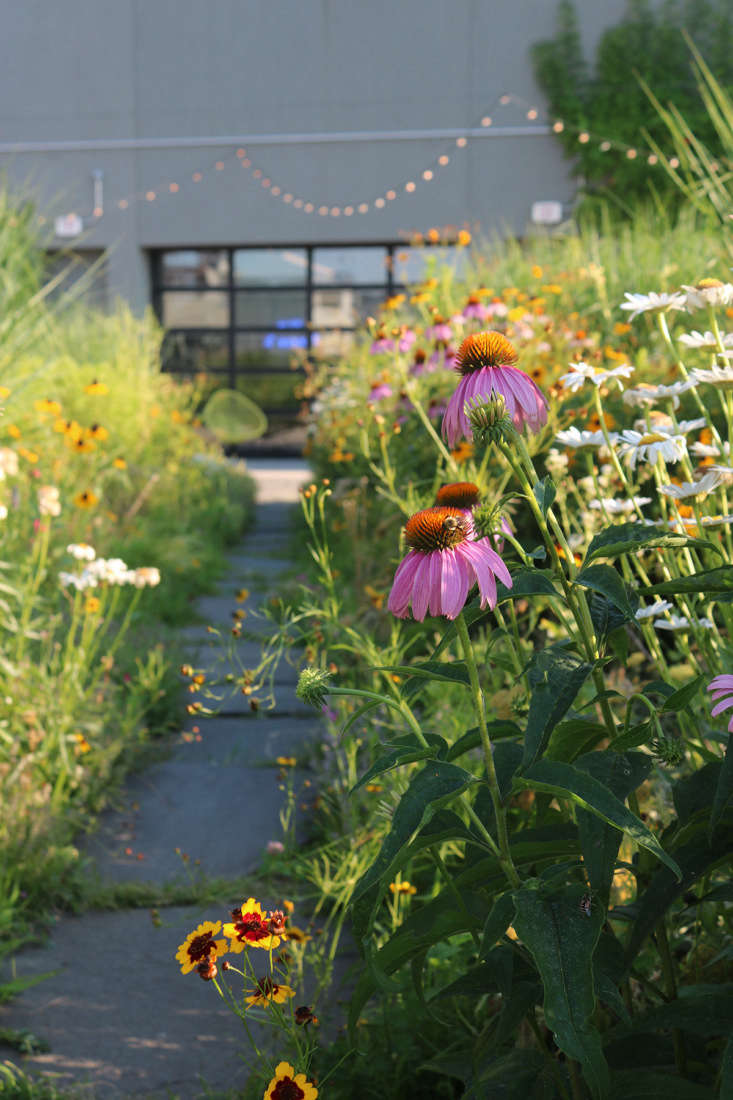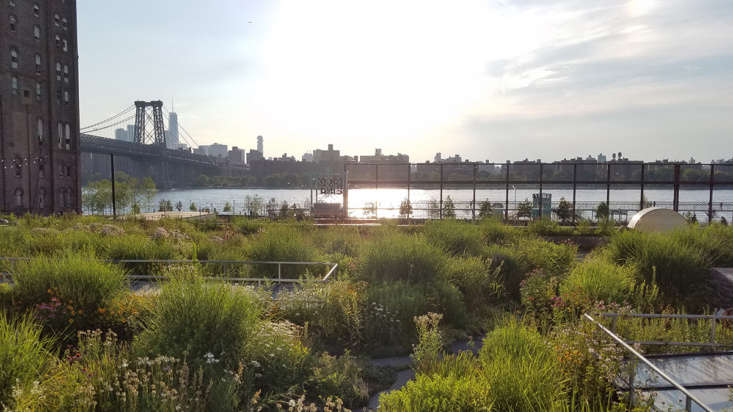If you have a 20,000-square-foot Brooklyn rooftop with selfie-worthy views of the Manhattan skyline, you should plant a pollinator-friendly meadow garden up there right away. That’s what the team at digital publishing and broadcast company Vice Media decided to do four years ago—and look how well it turned out both for the butterflies and for employees who like to snap sunset photos at #vicehq:
Photography by Marie Viljoen.

In 2014 Vice Media approached the design-build team at Brooklyn Grange Farm, which has a 43,000-square-foot-rooftop farm in nearby Long Island City, to ask for help in planting a rooftop vegetable garden at the company’s new headquarters.
Gwen Schantz, a founder and principal at Brooklyn Grange, saw the roof and knew that they could do a lot more than just a vegetable patch for the use of Munchies (Vice’s food website). “It was really a dream job,” she says.
Four years later, monarch butterflies drift across the flowers, settling briefly. Bees burrow into pollen. Luxurious, shoulder-height grasses tower above fragrant and diminutive thyme, crushed underfoot. Electric displays of echinacea and bee balm mirror the tri-state air traffic above, attracting every pollinator this side of the East River. And when you look up, 360 degrees of New York City wrap this botanical package in a big fat skyline ribbon, making it an enviable workspace.

The Vice team asked for 5,000 square feet of wooden deck, “but otherwise they gave me a lot of freedom in terms of design,” says Schantz. The deck is now divided into areas that include one perched atop a grassy mound, providing a perfect vantage point where hardworking (relaxing?) employees can enjoy the tidal rise and fall and water traffic of the East River below. Solar panels provide power for outdoor laptops and devices, and plug-in points are abundant.



Construction began in early spring of 2015, with a very tight timeline. The Brooklyn Grange team had to wait for the roofers to put in a new roof membrane before they could begin. “We were literally green-roofing and planting bit-by-bit every day while the roofers worked ahead of us to seal up the waterproofing,” says Schantz. “It was a high-speed, high-pressure build.”
Thousands of large, established perennial grasses and flowers were brought in from Georgia and Oregon (warmer than New York at that time of year), along with a couple of thousand blooming daffodils and crocuses for instant appeal. Vice threw a big bash that April, she says, and although it was only a couple of weeks old “the Vice garden was the greenest spot in New York City that month.”



A bill introduced to the New York City Council on July 18, requiring all new construction in the city to incorporate green roof systems (or solar power, or wind turbines), could breathe life into the sterile, wasted spaces atop buildings, potentially creating interconnected biomes within the concrete grid. Green roofs also lower city temperatures and harvest rainwater. And by now we all know that plants make people feel better.

In spring gardeners have observed birds collecting grass blades for nesting, and a couple of years ago a mallard duck laid 14 eggs (“Twelve hatched!” says Schantz) in a rooftop nest that she made here with some of the taller grasses.


Ashley Natale, Brooklyn Grange’s garden manager, oversees the vegetable garden’s health and maintenance, and uses crop rotation to prevent disease and pests (since they will often favor a certain crop family). “The Munchies test kitchen uses the food for recipe testing and guest chefs will forage for ingredients,” she says, “so it’s less about quantity production and more about growing varieties you can’t easily find.”


After suffering in the skewering sun, the lawn beyond (planted in a mere four inches of growing media) is now heavily seeded with white clover. Natale pronounces the experiment a success: “It’s low growing, can handle foot traffic, responds well to mowing, is drought tolerant, fixes nitrogen [making synthetic fertilizer unnecessary], and the bees love the blooms!” This refreshing approach to lawn-keeping—traditionally a realm were herbicide reigns supreme—also welcomes dandelions. “They really make our lawn look authentic in the spring,” says Natale. Dead nettle (Lamium pupureum) also has a place at the party, being one of the first signs of floral life after a long winter.

“But not all weeds are bad,” Natale says. The gardeners are conscious of the amount of material they remove and feel that many remaining weeds work aesthetically without monopolizing resources (they include Queen Anne’s lace, evening primrose, and Canadian fleabane—used in flower arrangements for the offices). A lot of time in spring is spent controlling the spread of mugwort, a weed and an herb with a long medicinal pedigree and huge culinary potential.

When darkness falls, perhaps they lie back on the clover lawn, and watch the stars come out over the city that never sleeps. Within reach of a power outlet, of course. Because digital publishing never sleeps either.
See more roof garden ideas in our curated guides to Garden Design 101, along with growing guides for more of our favorite hardy Perennials and Grasses. See more of our rooftop gardens in New York City:
- Ask the Expert: Roof Garden Basics with Designer Julie Farris
- Sustainable Farming: 10 Tips from the Brooklyn Grange
- A Manhattan Roof Garden with a Panoramic View
- Compost Dinner: A Zero-Waste Menu at Brooklyn Grange Farm









Have a Question or Comment About This Post?
Join the conversation